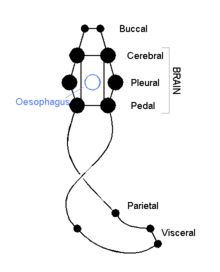- Nervous system of gastropods
-
 The dissected central ring ganglia of Lymnaea stagnalis. Scale bar is 1 mm.
The dissected central ring ganglia of Lymnaea stagnalis. Scale bar is 1 mm.
LBuG and RBuG: left and right buccal ganglia
LCeG and RCeG: left and right cerebral ganglia
LPeG and RPeG: left and right pedal ganglia
LPIG and RPIG: left and right pleural ganglia
LPaG and RPaG: left and right parietal ganglia
VG: visceral ganglion.The nervous system of gastropods consists of a series of paired ganglia connected by major nerve cords, and a number of smaller branching peripheral nerves.
The brain of a gastropod consists of three pairs of ganglia, all located close to the oesophagus. In some primitive forms, these ganglia are relatively discrete, but in most species they have become so closely bound together as to effectively form separate lobes of a single structure.
The cerebral ganglia are located above the oesophagus and supply peripheral nerves to the eyes, tentacles, and other sensory organs in the head. Beneath the oesophagus, at the forward part of the foot, lie the pedal ganglia. As their name implies, these supply nerves to the foot muscles.
The third pair of ganglia within the brain lie slightly behind and below the cerebral ganglia. These are the pleural ganglia, and supply nerves to the mantle cavity. Bundles of nerves connect the cerebral, pedal, and pleural ganglia together, as well as running above and below the oesophagus to connect the right and left cerebral and pedal ganglia to each other.
In most gastropods, a short pair of nerve cords passes forward from the cerebral ganglia to a pair of buccal ganglia located above the back of the mouth. These supply nerves to the radula and other parts of the mouth.
The main nerve cords of the central nervous system run through the length of the body from the pleural ganglia. In the ancestral gastropod, these would presumably have run down either side of the animal, but because of the torsion of the visceral mass found in many modern forms, they now cross over each other. However, a number of species have undergone de-torsion, restoring their original bilateral symmetry.
A pair of parietal ganglia lie along the length of the main nerve cords, supplying nerves to the gill and associated olfactory organ. Because of the torsion of the nerve cords, one parietal ganglion is typically higher in the body than the other. Finally, the nerve cords terminate in a linked pair of visceral ganglia, which supply nerves to the remaining organs of the visceral mass.
References
Barnes, Robert D. (1982). Invertebrate Zoology. Philadelphia, PA: Holt-Saunders International. pp. 366–368. ISBN 0-03-056747-5.
Further reading
- Benjamin P. R., Kemenes G. & Kemenes I. (2008) "Non-synaptic Neuronal Mechanisms Of Learning And Memory In Gastropod Molluscs". Frontiers In Bioscience 13: 4051-4057. doi:10.2741/2993, abstract, PubMed
- Chase R., Antkowiak T., Geoffroy E. & Weatherill D. (2004). "Why the ovotestis of Helix aspersa is innervated". Acta Biologica Hungarica 55(1-4): 239-249. doi:10.1556/ABiol.55.2004.1-4.29. PubMed.
External links
Categories:- Gastropods
- Mollusc anatomy
- Nervous system
Wikimedia Foundation. 2010.


